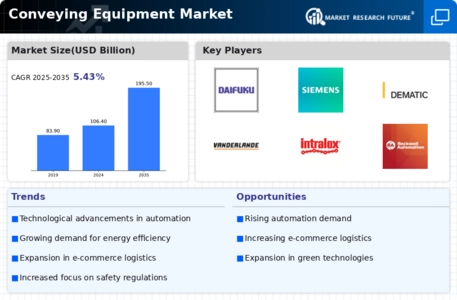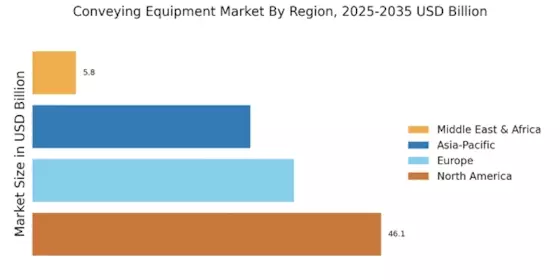Increased Automation
The Conveying Equipment Market is experiencing a notable shift towards automation, driven by the need for enhanced efficiency and reduced labor costs. Automation technologies, such as robotics welding and smart sensors, are being integrated into conveying systems, allowing for real-time monitoring and control. This trend is reflected in the projected growth of the automation sector, which is expected to reach a valuation of over 200 billion dollars by 2026. As industries seek to streamline operations, the demand for automated conveying equipment is likely to rise, thereby propelling the overall market forward. Furthermore, the adoption of Industry 4.0 principles is fostering innovation in the Conveying Equipment Market, as companies aim to optimize production processes and improve supply chain management.
Focus on Safety Standards
Safety regulations and standards are becoming increasingly stringent across various industries, thereby impacting the Conveying Equipment Market. Companies are compelled to invest in equipment that not only meets operational efficiency but also adheres to safety protocols. This has led to the development of advanced conveying systems equipped with safety features such as emergency stop mechanisms and overload protection. The emphasis on workplace safety is reflected in the growing market for safety-compliant equipment, which is anticipated to reach a valuation of approximately 50 billion dollars by 2025. As organizations prioritize employee safety, the demand for compliant conveying equipment is likely to drive growth within the Conveying Equipment Market.
Rising Demand in E-commerce
The surge in e-commerce activities is significantly influencing the Conveying Equipment Market. As online shopping continues to gain traction, logistics and warehousing operations are expanding to meet consumer demands. This has led to an increased need for efficient conveying systems that can handle high volumes of goods swiftly and accurately. According to industry reports, the e-commerce sector is projected to grow at a compound annual growth rate of over 15% in the coming years. Consequently, the demand for advanced conveying equipment, capable of supporting automated sorting and distribution processes, is expected to rise. This trend underscores the critical role of the Conveying Equipment Market in facilitating the seamless movement of products within the supply chain.
Expansion of Manufacturing Sector
The ongoing expansion of the manufacturing sector is a key driver for the Conveying Equipment Market. As production facilities scale up to meet increasing consumer demand, the need for efficient material handling solutions becomes paramount. The manufacturing sector is projected to grow at a rate of around 4% annually, which will likely necessitate the adoption of advanced conveying systems. These systems enhance productivity by facilitating the smooth movement of materials throughout the production process. Additionally, the rise of smart manufacturing practices is encouraging the integration of innovative conveying technologies, further propelling the market. This trend indicates a robust future for the Conveying Equipment Market as manufacturers seek to optimize their operations.
Sustainability and Eco-friendly Solutions
Sustainability is emerging as a pivotal concern within the Conveying Equipment Market. Companies are increasingly seeking eco-friendly solutions that minimize environmental impact while maintaining operational efficiency. The demand for energy-efficient conveying systems is on the rise, as organizations aim to reduce their carbon footprint. This shift is supported by government initiatives promoting sustainable practices, which are likely to influence purchasing decisions. The market for green technologies in material handling is expected to grow significantly, with projections indicating a potential increase of over 20% in the next five years. As sustainability becomes a core focus, the Conveying Equipment Market is poised to adapt and innovate, aligning with the broader goals of environmental stewardship.


















Leave a Comment